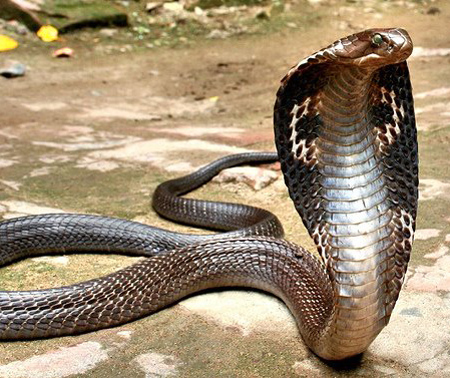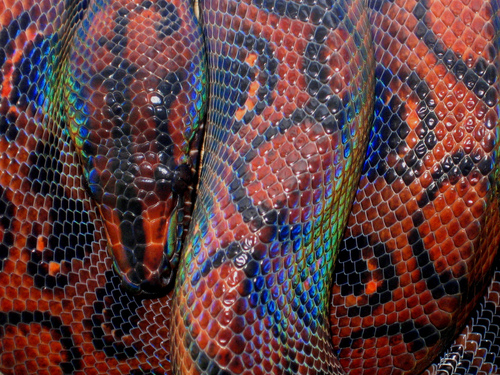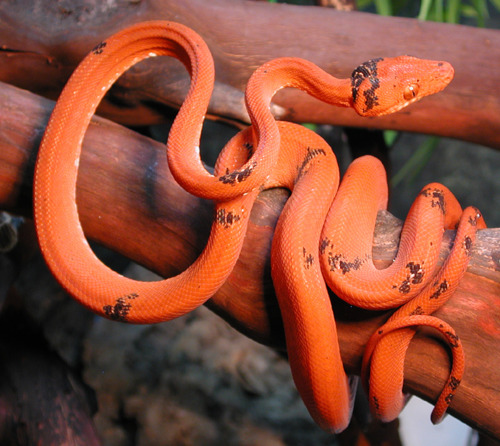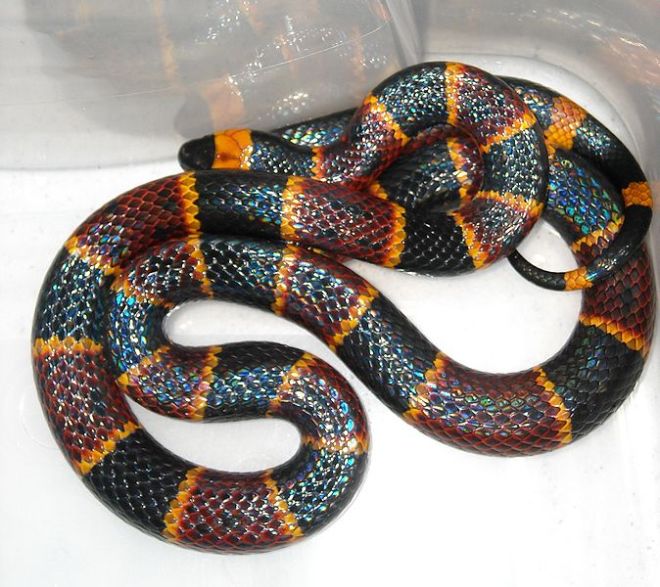The king cobra (Ophiophagus hannah) is the world’s longest venomous snake, with a length up to 5.6 m (18.5 ft).[1] This species, which preys chiefly on other snakes, is found predominantly in forests from India through Southeast Asia to Indonesia and the Philippines. Despite the word “cobra” in its name, this snake is not a member of Naja (“true cobras”) but belongs to its own genus. The king cobra is considered to be a dangerous snake.[2][3][4] It has cultural significance as well.[5]
Tag Archives for snake
Brazilian Rainbow Boa
Amazon Tree Boa
These animals are notorious for being very aggressive, although as with all snakes this varies. These animals also have very long needle-like teeth which makes their bite quite painful. However these snakes tend to give some warning of being inclined to bite, and will usually give fairly gentle bites (which can still draw blood) unless they are given reason to give a full strike.
The aggressiveness is in part due to the species feeding cycle. The snakes are night time hunters, so they are in hunting mode when they are most likely to be handled by an owner. Being in a hunting mood and being that an owners hands are usually nice, hot and prey sized (Amazon Boas hunt mainly using their heat sensors) – people do get bitten, although as with most snakes, the animal will soon realise their mistake and let go, since they can recognise the smell of their owner. It is uncommon for a constrictor snake that knows the person handling it to strike and constrict the person, as they would a food item, unless the snake is very agitated.
Coral Snake
The coral snakes are a large group of elapid snakes that can be subdivided into two distinct groups, Old World coral snakes and New World coral snakes. There are 11 species of Old World coral snake in one genus (Calliophis), and over 65 recognized species of New World coral snakes in three genera (Leptomicrurus, Micruroides, and Micrurus).
Leucistic Texas Rat Snake
The Texas rat snake (Elaphe obsoleta lindheimeri) is a subspecies of rat snake, a nonvenomous colubrid found in the United States, primarily within the state of Texas, but its range extends into Louisiana, Arkansas and Oklahoma.[1] It intergrades with other subspecies of Elaphe obsoleta, so exact range boundaries are impossible to distinguish.[2] The epithet lindheimeri is to honor the German-American naturalist Ferdinand Jacob Lindheimer, who collected the first specimen in New Braunfels, Texas.
Ribbon Snake
this snake is found in north america and it is a type of garter snake.
there are Eastern, Northern, Southern, and Western species of ribbon snakes. they’re found all over the US and are all generally the same, other than the climate range, and obviously the part of the country they’re in.
they like to be near water and can be found in forests and rocky hillsides, and most frequently are seen climbing or resting in the dense vegetation around a bog, lake, marsh, pond, stream, river, or even seeping spring.
it is 16-35 inches long
they eat worms, slugs, minnows, insects, small mice, and toads.The typical time for snakes to hunt is in the morning or early evening
Ribbon snakes are also common pets. They are easily found in pet shops for up to 30 dollars. A single snake can fit in a ten gallon terrarium.
and are normally very calm and docile
Ribbon Snakes rarely bite when handled but they do produce a foul musk from their anal glands when they feel threatened.
Worm Snake

Worm snake is the common name sometimes given to several of snakes. They share the characteristics of small size, primarily subterranean habitat, non-functioning or small eyes, and varying resemblance to earthworms. Many are also known as Blind snakes, the alternative common name. The worm snake is indeed a snake although there are myths of it possibly being a lizard with very tiny legs. There are also myths of the worm snake possibly being the offspring of a male snake and a female worm, this is not true though.
Eastern Green mamba
The Eastern Green mamba (Dendroaspis angusticeps) is a medium sized, arboreal, highly venomous snake of the family Elapidae.
The Eastern Green Mamba is overall glossy green in colour with a lighter bright greenish-yellow belly. This is the smallest of the Mambas, averaging only 1.4m (4.6ft) in length.The maximum size for this species is 2.4m (7.9ft), but this is uncommon.Male Eastern Green Mambas are generally slightly larger than the females.
Eastern Green Mamba’s are an arboreal species and thus are almost always found in trees. They very rarely venture to the ground unless driven by prey or for their need to bask under the sun. They are also not usually found in open terrain.Thickly forested and bush-covered areas such as evergreen forests, mainly make for this species’ habitat. They can also be found in regions like coastal scrub, woodland, moist savannah, bamboo and mango plantations. The species can even be found in dense montane forest up to about 1,700m (5,600ft) above sea level. They’re often found in thickets and farm trees (citrus, cashew nut, coconut and mango) which offer plenty of shade. In coastal east Africa it is known to enter houses and often shelters in thatched roof dwellings.They may even be found in tropical or sub-tropical regions within their range.








You must be logged in to post a comment.